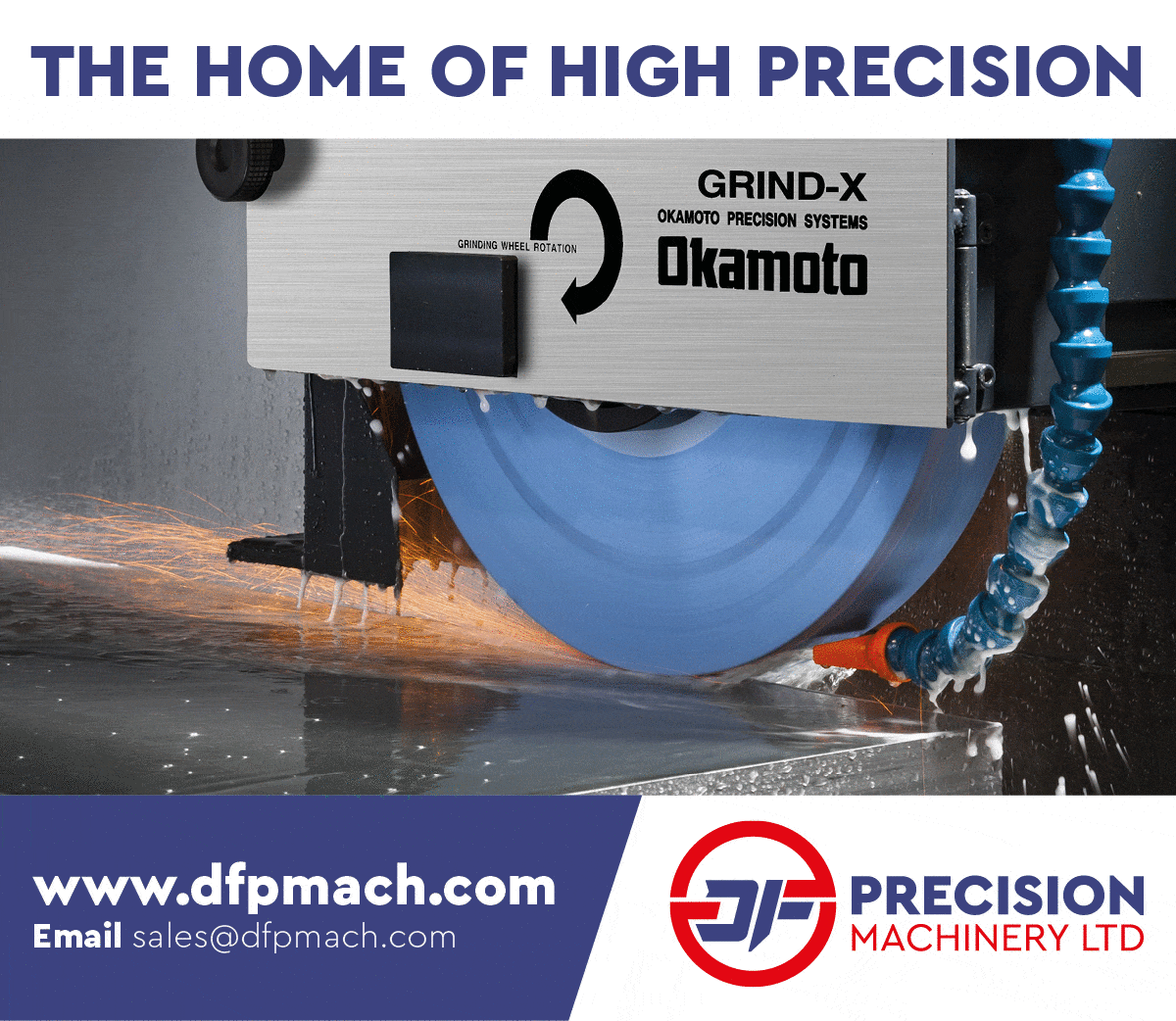The VOLLMER argon has arrived
Published: | VOLLMER, argon

The VGrind tool and cutter grinding machine has been around for almost 10 years, with VOLLMER making periodic iterations and upgrades to account for industry evolution and technological advancements. Now, the Biberach manufacturer has introduced three new VGrind variants all at once. Here, we’ll explain the positioning of the new machines and the differences between them - with particular emphasis on the new argon machine.
When it created a vertically positioned twin-spindle tool and cutter grinding machine concept back in 2014, VOLLMER broke all the realms of convention with its VGrind. Now, acting decisively on its industry research and customer feedback, VOLLMER is driving the VGrind forward with the launch of three new additions, the new VGrind neon and argon ‘editions’ and the VGrind 260 machine. So, what is the concept behind the new machines and what is the difference from the existing models?
With existing VGrind models demonstrating extremely high levels of productivity, flexibility, automation and above all quality – the balance of specification versus ‘price-point’ was potentially beyond the requirement of some manufacturers. To address this balance for particular customers, VOLLMER has introduced the new machines. Fundamentally, the VGrind neon, argon and 260 all have precision ballscrew drives as opposed to linear motors on the existing 340S and 360S models. This reduces the ‘price-point’ of the new machines. And then we get to the difference between the three new model variants….
To discuss this, Andreas Weidenauer, the Chief Representative Office & Business Development Manager at VOLLMER tells us more. “The VGrind 260, neon and argon incorporate ballscrew drives whereas the existing VGrind 340S and 360S variants are linear drive machines, this lowers the cost barrier for small businesses and makes the technology more accessible. The VGrind 260 machine is a package, it was created as the foundation base for the neon and argon variants. The VGrind 260 is the configurable base model that can be tailored to meet the exact needs of the end-user whereas the neon and argon machines have restrictions on the available options. The VGrind 260 enables customers to review the various packages and create a machine bespoke to their needs and budget.”
“With the neon and the argon - we listened to the market and asked what their minimum requirements are from a machine, this is where these two new machines come from. The neon is a machine without the loading system and wheel changer. This means the neon has a limited number of options and is fundamentally a machine package without automation that creates a price that delivers a cost-efficient solution for manufacturers and re-sharpening shops. The argon does have automation features and sits comfortably between the manually loaded neon machine and the 260 machine that can incorporate all conceivable extras.”
Further alluding to the argon, Andreas says: “If there is a company that likes to overcome short staff breaks like lunch, maybe they wish to continue producing tools unmanned for a short period at the end of the shift or ‘free-up’ staff to handle more machines – the argon is the machine. With this, we have provided this automation capability with an internal loading system. It introduces an internal tool loader for all of the tools - it facilitates drills, end mills and all types of tools. If the neon is a package machine without automation, the argon is a package with automation.”
What’s New?
So, same enclosure and the same equipment as the neon – not quite. Whatever the VGrind neon can do, the argon can too – and then some. So, the same as the VGrind 260 then? Not quite. The VGrind 260 provides the complete option of 8 grinding wheel packages with interchangeable coolant elements as well as the external automation systems that include the HP160 pallet magazine for up to 900 blanks or the HC4 chain magazine for 158 shank tools or up to 52 HSK-A63 tool holders. The argon doesn’t stretch this far.
The argon provides a 4 station grinding-wheel changer and an internal pallet loader only. This machine is a step between the manually loaded and operated neon and the fully automated VGrind 260, offering increased comfort and flexibility for different batch sizes. To create this package that sits between the manual neon and the fully automated 260, VOLLMER has developed a completely new grinding wheel changer system and an entirely new internal pallet loading innovation.
New Loading System
Discussing this, Andreas says: “We already had an internal loading system on the VGrind, but with the feedback from the customer, we increased the capacity – putting two pallets into the machine instead of just one to extend the range of the machine. So, the argon has a wider range and capacity, it can also be more flexible than ever before. These are three key points that we addressed and enhanced with this new loading system. Previously, we had the facility for 20 to 40 tools on a single pallet, but this depended on the tool diameter. Now, we have a different gripper system and this allows us to put up to 300 tools/blanks on a single pallet. However, this maximum capacity of 300 tools does depend upon the shank diameter. For example, with 3 to 6mm blanks, we can accommodate 300 tools but with 20mm diameter tools, we can fit 32 tools. The previous internal loading system with a single pallet that was on the VGrind 360 machine could facilitate 40 tools from 3 to 5mm diameter and 20 tools up to 20mm diameter – the new system on the argon has a much higher capacity for tools or blanks.”
Andreas continues: “This is a major step forward in our automation technology as we have made this possible by retaining the same machine footprint. The difference between the previous system to the new one is that we have created an additional axis and more space inside the machine. Previously, we put the single pallet on the A-axis, now we have two pallets on the A-axis and when we don’t need it, or if we don’t use the loader, we just slide the two pallets back out of the way.”
“Our engineers have introduced new technologies such as an impressive new gripper system. The modification of the gripper and also the installation system has made it possible to have two pallets inside the machine. Now, we have one pallet with the raw blanks and the gripper can remove the parts and put them in the completed part pallet after processing. The new gripper is a single gripper system that requires less space to clamp tools, this means that more tools can be accommodated in the pallet as there is less space between each tool position.”
New Grinding Wheel Changer
Another new feature with the argon is the automation for the grinding wheel packages. Alluding to this, Andreas continues: “If we implemented our existing wheel changer with eight stations, this may be too many positions for many customers - something that subsequently adds more cost to the machine. With the argon, we have integrated a new wheel changer with four stations. This gives four-wheel packages and these can only be exchanged on the upper spindle. This has reduced our production costs as the existing wheel changer moves up and down to both the upper and lower spindle. The grinding wheel changer is a fixed unit with four arms that change the four wheel packages, this is only interchangeable on the upper spindle. With one wheel package already installed in the lower spindle, this provides a total of five grinding wheel packages. With reduced wheel packages and the fixed position for the upper spindle, this reduces our production cost and again, makes the machine more cost-effective for the customer.”
With definitive changes to the grinding wheel changer system and the innovative upgrade to the internal tool automation system, the VGrind argon is a well-adapted machine for manufacturers and re-grinding shops making early steps forward in the production of rotary solid carbide cutting tools. The argon retains the features and technology from other VGrind models that have been the benchmark in the sector since launch. For example, the argon incorporates the VOLLMER wheel measurement probe, glass scales and an intelligent cooling concept with heat plate exchanger, as well as the fundamental stable wall concept that provides a very rigid, compact construction with temperature-stable polymer concrete.
The two vertical positioned grinding spindles with the grinding wheel at the C-axis pivot point are a given; as is the ergonomically positioned control unit with a 19" touchscreen that gives the user ease of use and an optimal view into the machining area. The modern interface has an intuitive and easy-to-use Numroto control system with the 3D tool and machine simulation and collision monitoring. Taking this machine generation into the Industry 4.0 sphere, the argon is fully communication-enabled and the VOLLMER IoT gateway is fitted as standard, opening the door to the digital world for customers.
Capable of processing tools to 200mm diameter with an overall length up to 360mm, the VGrind argon has X, Y and Z-axis travel of 425 by 490 by 500mm with an infinite A-axis that can rotate at 450rpm. The two belt-driven spindles with HSK50 adaption are capable of a maximum speed of 10,500rpm and 6,500rpm with a maximum torque of 14 and 7Nm respectively.
Vollmer UK Ltd
Tel: 0115 9491040
Email:
www.vollmer-group.com
Quick Links
Telephone
Published By
Roger Barber Publishing
4 Mayfair Court
Cleethorpes
South Humberside
DN35 0QG
© Copyright Roger Barber Publishing , all rights reserved.
Terms and Conditions apply. This website uses cookies, click here for blocking details. Our Privacy Policy is available here.

